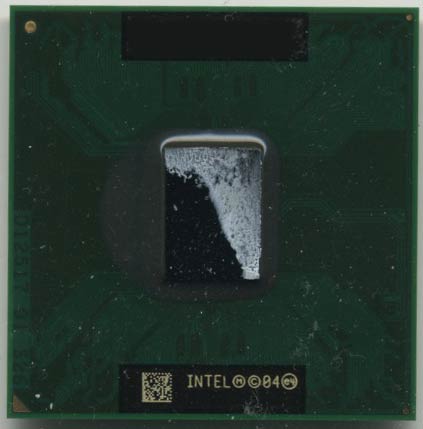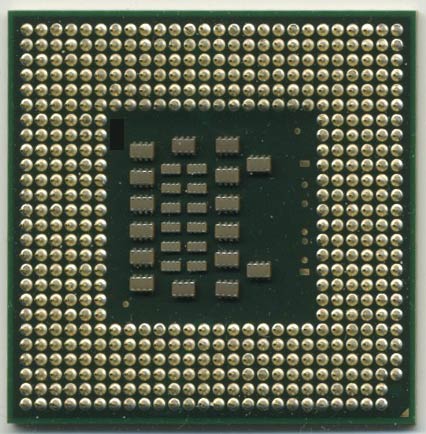Intel Yonah Performance Preview - Part I: The Exclusive First Look at Yonah
by Anand Lal Shimpi on November 30, 2005 2:50 AM EST- Posted in
- CPUs
Intel, oh Intel, how uninteresting your processors have been to us for so long now. Where have the days of the Northwood gone? Prescott brought us a minor bump in clock speed, minor increases in performance, and more importantly - major increases in power bills. But if any company can go down the wrong path for five years and still come out on top, it’s Intel. So starting next year, we’ll start seeing a new Intel. A more power conscious Intel and to kick it all off will be Intel’s first Earth-friendly dual core processor: Yonah.
As the successor to the current Pentium M (Dothan) and the predecessor to next year’s Conroe, Merom and Woodcrest cores, Yonah is a very important chip. As a mobile processor Yonah will bring dual core to thin and light notebooks, basically anywhere you’d find a Pentium M, you’ll now be able to find two Pentium Ms. The implications for mobile performance are huge, as multitasking on notebooks has rarely been all that great of an experience. At the same time, Yonah is so much more than just a dual core mobile processor - it’s a predictor of the performance of Intel’s next-generation desktop micro-architecture. Sure, it won’t have all of the architectural bells and whistles that we’ll see when Conroe debuts at the end of next year, but it’ll have many and that makes it a reference point.
The problem with the Pentium M architecture has been that although it’s traditionally done well at office tasks and obviously in the power consumption department, it has lagged behind the Pentium 4 and Athlon 64 when it comes to FP intensive applications such as video encoding, and to a lesser degree, 3D gaming. With Yonah, Intel has promised to address those performance issues, and even more so with their next-generation micro-architecture later next year. But we tend to want to see things for ourselves, and Yonah will at least give us an indication of how things have improved since Dothan, and whether or not Intel is on the right track to replacing the Pentium 4.
By now we’ve hopefully stressed the importance of Yonah, and there’s just one more detail to mention - we have one.
The Platform - Yet Another Socket
While the launch of Yonah still won’t be until January of next year, we’ve had a chip for the past month, unfortunately, we haven’t had a motherboard to stick it in. We finally got one two days ago, which is why you’re seeing this article now, instead of more pictures of our Yonah posing alongside the Xbox 360. The problem is that Intel seems to have changed sockets once more, meaning that Yonah is not backwards compatible with the original Pentium M socket.

If you’ll remember back to the introduction of the Pentium M, Intel introduced a brand new socket for the processor: Socket-479. Back then, the desktop Pentium 4 still used the pin-based Socket-478, so the different pin-out was a bit of a pain to deal with as we all wanted to be able to stick Pentium Ms in our Pentium 4 motherboards.

The Yonah socket is still a 479-pin interface, however the pin-out has been changed once more, and of course Yonah won’t even physically fit into any current Pentium M motherboards. Instead, you’ll need a brand new motherboard with a brand new chipset. So if you invested in any of the handful of desktop Pentium M motherboards that were released over the past year, you’re unfortunately out of luck.

Yonah (left) vs. Dothan (right) - Note the different pin-out
What’s this about a new chipset? Well, it’s not exactly a new chipset, rather it’s Intel’s mobile 945 chipset - the mobile version of the desktop chipset we’ve had for quite some time now. The platform we’re testing on in particular uses Intel’s 945G chipset, with integrated graphics, but of course we aren’t too interested in integrated graphics performance so we’ll be using the PCIe x16 slot on the board.
While we can’t tell you who makes the motherboard we’re testing with, the important thing to note is that it is a desktop motherboard made specifically for Yonah. It’s got a single PCIe x16 slot, meaning you don’t have to rely on integrated graphics, and all of the bells and whistles you’d expect from a desktop motherboard; this could very well be the heart of your next system.
We’ve been hearing that Pentium M based desktops will become a lot more common next year, and this motherboard is definitely an indication of that.










135 Comments
View All Comments
Missing Ghost - Wednesday, November 30, 2005 - link
Why no EM64T???They should add this, or I'll buy Turions.
fitten - Thursday, December 1, 2005 - link
Do you really *use* 64-bit software today? or just run it to say you run it? or just dream of running 64-bit software? I think Intel is pretty much right-on with what they said about 64-bit in the mobile market. I don't know of anyone who would really do anything with 64-bit right now other than just "have it". I have it at home because I write software that I test on both 32-bit and 64-bit platforms. Other than that, I have no use for 64-bit software yet. I don't run massive databases, I don't run massive CFS/CFD simulation codes. I don't run GIS software where I worry about having the entire world in memory mapped to the nearest centimeter. 32-bit is still fine. I'd like to have a 64-bit laptop myself, but that's so I could develop/test the software I write and not for much other reason.Also, 64-bit is more transistors which means more power draw.
tfranzese - Thursday, December 1, 2005 - link
Business users I've seen tend to hold on to laptops for quite some time, and when they are done with them they sometimes end up in another groups hands where they can use it for hosting/serving small applications, and not limited to legacy software/OSs.I think it's a big misstep to not engineer 64-bit extensions into Yonah. As I mentioned earlier, almost every processor being sold today is a 64-bit desktop or server CPU. With that kind of penetration, it's only a matter of time (which is fast approaching) when 64-bit Windows development will pick up speed. Vista is getting very close (~1 year) and this chip isn't even released yet.
Shintai - Thursday, December 1, 2005 - link
Business also dont tend to upgrade early. The larger the slower basicly.So a 32bit desktop and laptop will be fine the next 5 years or more. Alot still uses windows 2000 and havent even moved to XP and 2003 server.
Just because the ubergeek can get Vista before xmas 2006 doesn´t mean any business will implement it.
stateofbeasley - Thursday, December 1, 2005 - link
Again, the problem is the assumption that Vista is x64 only - that is wrong. Vista has concurrent x86 and x64 builds. The assumption is that Microsoft will make all software x64 once Vista is out - that is also a foolish assumption to make, given that MS has said nothing about moving office to x64 only.Businesses are also going to be very slow to adopt 64-bit OSes for clients. Where I work we upgraded to Windows XP last month. Our IS department isn't planning to roll out Vista any sooner than 2008 - they want at least one service pack (preferably two) and a few months to validate.
People at AnandTech tend to view these things from the enthusiast standpoint, which is far different than the business standpoint. What makes sense from the enthusiast standpoint is often idiocy from the perspective of a department responsible for maintaining a corporate infrustructure comprising hundreds or thousands of machines.
BrownTown - Thursday, December 1, 2005 - link
32 or 64 bits is just marketing stuff. What matters is performance, if a 32bit processor can put out the same performance as a 64bit one then its just as good in my book. Also, people arent gonna go buy Vista as soon as it comes out, it mostly be sold only in new computers. And by the time it comes out Intel should have Mermon ready which does have the 64bit extensions. Im sure Intel considered this and figured that the added transisters were to much to account for the benefit.Scarceas - Wednesday, November 30, 2005 - link
I think the mobile market could REALLY benefit from two different cores...A low-power core for most of the time, that will extend battery life while providing enough performance for web browsing and word processing... and a higher performing core for when the performance is needed.
Pipe dream?
Furen - Thursday, December 1, 2005 - link
Two different cores on the same package? That's what speedstep is for. If you dont need the power you run at low clock speeds and clock up when you do. This way you dont duplicate logic.miketheidiot - Wednesday, November 30, 2005 - link
i thinks its interesting that pepole are freaking out here because a top end intel dual core managed to come close to AMD's bottom of the line dual core chip. I think that says alot about intel now days.Hikari - Wednesday, November 30, 2005 - link
Ahh, yes, a dual core mobile cpu using less power comes out close in speed (faster, the same, and sometimes slower, depending on the test) to a low-end desktop dual-core. ;)